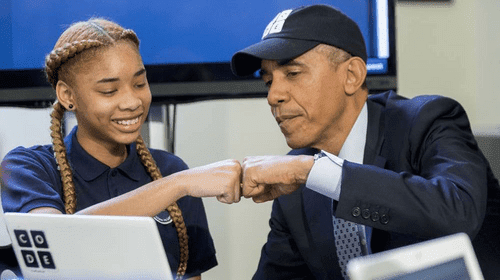Paige Kissinger
Staff Writer
Have You Done the Hour of Code?
 Have you seen those posters for Hour of Code near the main entrace hanging up? To date, 70 million people have done the Hour of Code, twice as big as last year! Across 180 countries, these people are learning new skills. The Hour of Code welcomes everybody – both students and adults – interested in computer science. People learn how to code on everyday technology during the week of December 8 to the 14 for its second annual event. Mr. Czarnecki wants more students to participate; even if you might not be experienced in coding, you can still learn the basics if you’re interested.
Have you seen those posters for Hour of Code near the main entrace hanging up? To date, 70 million people have done the Hour of Code, twice as big as last year! Across 180 countries, these people are learning new skills. The Hour of Code welcomes everybody – both students and adults – interested in computer science. People learn how to code on everyday technology during the week of December 8 to the 14 for its second annual event. Mr. Czarnecki wants more students to participate; even if you might not be experienced in coding, you can still learn the basics if you’re interested.
There are many supporters such as Mike Zuckerberg, one of the five co-producers of Facebook, President Obama, Ashton Kutcher, and Marissa Mayer, the president and current CEO of Yahoo, and others. Czarnecki teaches the Mobile App class, where students learn how to build mobile apps using MIT’s App Inventor 2 that will be on the Google Play store, hopefully be the end of the semester.
 Students are encouraged to go on the website, www.code.org, to learn more information to be involved and learn more about new technology. On the website, there are several different links that can be used that include online tutorials and videos on the Hour of Code. There are videos introducing the several ways that computer science and coding can have on everyone and many activities.
Students are encouraged to go on the website, www.code.org, to learn more information to be involved and learn more about new technology. On the website, there are several different links that can be used that include online tutorials and videos on the Hour of Code. There are videos introducing the several ways that computer science and coding can have on everyone and many activities.
Last year, Czarnecki explains that the Hour of Code went well in his classes. Czarnecki said, “If teachers want to do it, I’d love for them to do it or try it out. But if they can’t I understand.”
Czarnecki enjoys watching and listening to videos from top business executives around the world. He said “They give such great tips and it’s interesting to see that even they had to start of with the basics at some point.” Yesterday the site was down due to the large amount of people going on the site, but the Hour of Code can be done anytime within the next two weeks. Their goal is to reach 100 million people and is only hoping for the best!
The crowdfunding campaign is also setting their own goals – to raise $5 million. These funds will be used to bring computer science to 25,000 new classrooms by 2016. “For each dollar you give, one student will learn.” Please support their work.







